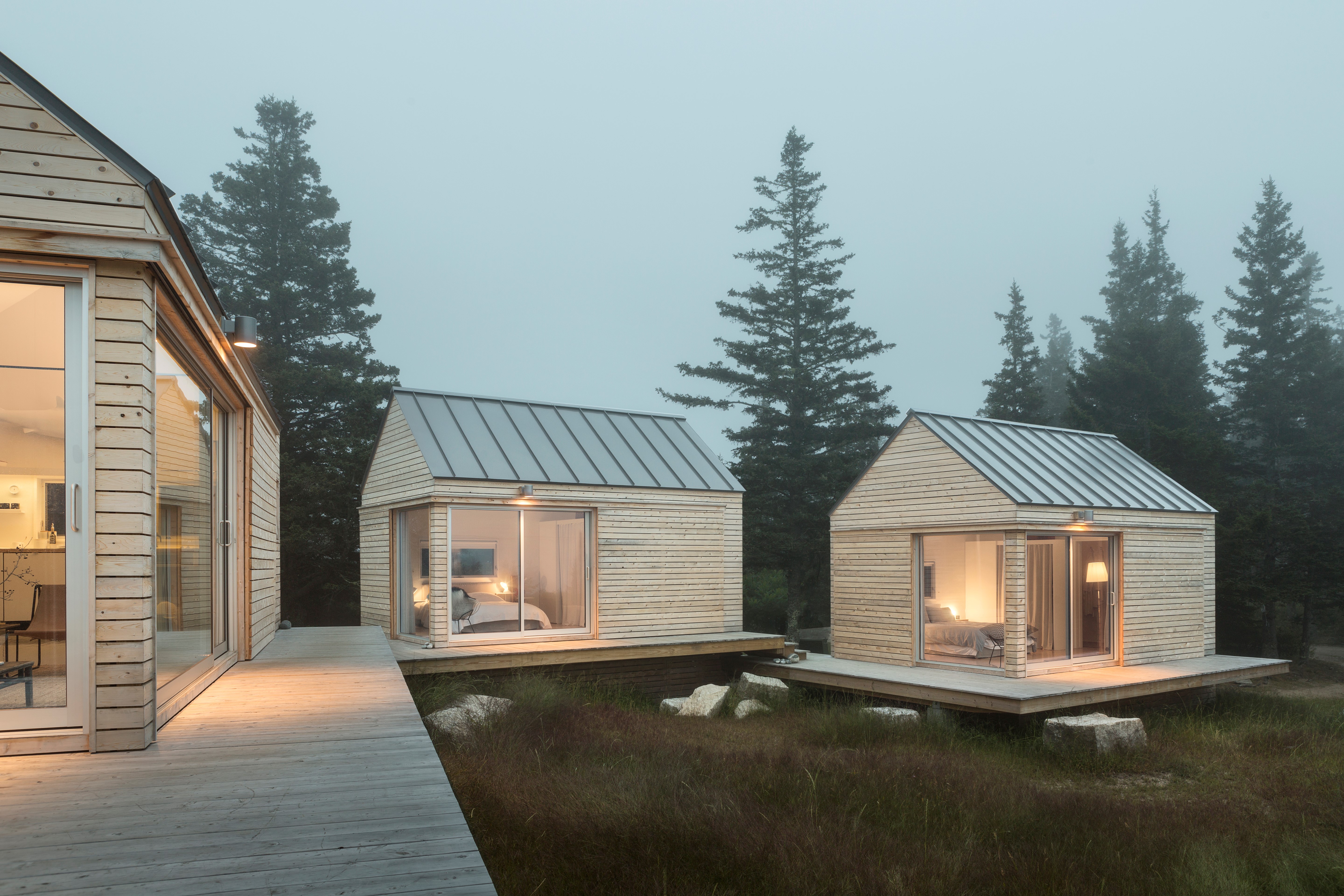
Photo: Trent Bell
AMONG EMERGING WOOD TECHNOLOGIES, few have as much buzz as mass timber, or cross laminated timber (CLT). The pre-fabricated, solid-wood panels are touted as a climate friendly, labor-saving alternative to concrete and steel in the construction of large buildings. Recently, two companies have announced plans to open separate CLT manufacturing plants in Maine. To date, very few Maine architects have experience with CLT. Lee Burnett spoke with one of them, Riley Pratt of GO Logic in Belfast, designer of a cluster of micro-cabins on Vinalhaven known as “Little House on the Ferry.”
 The panels. Manufacturer Nordic Structures glues up crisscrossed layers of black spruce and precuts openings for windows and doors. The cabin panels generally measured 8 feet by 26 feet and 4.25 inches thick. They were lifted into place with a crane and assembled with fasteners, much like a piece of Ikea furniture.
The panels. Manufacturer Nordic Structures glues up crisscrossed layers of black spruce and precuts openings for windows and doors. The cabin panels generally measured 8 feet by 26 feet and 4.25 inches thick. They were lifted into place with a crane and assembled with fasteners, much like a piece of Ikea furniture.
How CLT solved a problem. The cabins are an atypical use of CLT, the sweet spot for which is in the construction of low and mid-rise apartment buildings. But CLT solved some problems with the island site. The lot is a former granite quarry with ledgy, uneven terrain. A conventional foundation was impractical, but foundation piers of varying heights spanned by rigid panel floors fit the bill. In addition, CLT was suited for the character of a seasonal cabin because the interior faces of the panels could serve as finish walls. “There was a real economy and simplicity to using CLT,” said Pratt.
The learning curve. Pratt learned about CLT a dozen years ago while working at Marmol Radziner, a California design-build firm specializing in pre-fab architecture. But it wasn’t until 2012 at GO Logic that he had his first opportunity to work with it. “It really wasn’t that difficult,” he said. The cabins themselves are simple structures. “It’s not like we were trying anything adventurous.” The structural engineering was provided by the builder, Bensonwood. The panels themselves came as a “turnkey” package. The stack of panels was assembled in reverse sequence in which they would be used, which reduced handling. And the panels were already embedded with structural steel tie rods, which saved another step.
Price. “We compared the price with conventional construction and it pretty much came out as a wash. We saved on labor, but we had lost ground because we paid more for materials.” The price of panels from northern Quebec was less than competing products from Europe. “We did an analysis that justified its use.”
Advantages. Pratt likes the speed of assembly. “The first day we had all the floors laid and one of the structures.” Assembly was completed in the five days allotted, even though they lost time on windy days when it was too dangerous to swing panels into place with a crane. Pratt also likes the rigidity of the panels. “That thin floor assembly… is just kind of liberating. The panels span in two directions and are very stiff, such a robust material.” And he likes that the panels are value-added products from lowgrade wood. “I kind of think of it [Quebec] as local. I like the idea that the wood is from the same environment.”
Tradeoffs. Special allowances much be made for plumbing and wiring, which can’t be run in solid walls. That was solved by putting the utilities in the space inside interior walls. CLT also requires additional planning because it is more difficult to make changes “on the fly.” “It just front loads everything.” Finding skilled labor can be a challenge. Pratt finds timber framers are best suited to the work.
Project impact. The cabins have garnered design awards and publicity. “The reason I think it is quite popular is that the cabins seem approachable to people. It’s not something for the one percent… It’s just quite simple and approachable, but I don’t think it’s so much the CLT. It’s a blend of the vernacular with a modern approach to windows and siding.”

This article was reprinted from the spring/summer 2018 issue of Green & Healthy Maine HOMES. Subscribe today!







